Overview
This article emphasizes the crucial role of identifying essential autism tests for children, which can significantly aid in the early detection of autism spectrum disorders. It highlights valuable tools such as the M-CHAT-R, ADOS, and SCQ, showcasing their effectiveness in screening and diagnosing autism. Understanding these tests is vital, as timely intervention can lead to improved developmental outcomes for children facing these challenges. As a caring community, we must support one another in navigating these important resources.
Introduction
In a world where autism touches the lives of millions, the significance of effective evaluation and intervention strategies is truly profound. At ASD Media, we are dedicated to this mission, providing a wealth of resources and support designed to enhance the implementation of ABA therapy and improve outcomes for children with autism.
As the landscape of autism evaluation evolves, various screening and assessment tools have emerged, each playing a vital role in early detection and diagnosis. From the Modified Checklist for Autism in Toddlers to comprehensive behavior assessments, these tools not only assist professionals but also empower parents to navigate the complexities of autism with confidence.
Join us as we explore the spectrum of available resources, highlighting their importance in nurturing a supportive community and ensuring that individuals with autism receive the timely interventions they need to thrive.
About ASD Media: Comprehensive Resources for Autism Evaluation
At ASD Media, we are deeply committed to enhancing the application of ABA therapy. Our focus is on providing a wealth of resources and strategies designed to address the challenges faced in evaluating individuals with developmental disorders, such as the autism test for children. With approximately 5.4 million adults on the spectrum in the U.S., the need for effective evaluation techniques, such as an autism test for children, has never been more critical. We believe in empowering both parents and professionals by nurturing a supportive community where experiences and insights can be shared. This collaborative environment ultimately leads to better outcomes for children. We recognize that community support is vital in the developmental evaluation process. It not only helps navigate the complexities involved but also addresses the mental health needs of parents, who often endure heightened stress and anxiety, as highlighted by research on parental stress and mental well-being.
By offering access to valuable resources and raising awareness through informative articles, ASD Media ensures that individuals are well-equipped to tackle the complexities of evaluation. Together, we can pave the way for early detection and intervention, fostering a brighter future for our children.
M-CHAT-R: Effective Screening Tool for Early Autism Detection
The Modified Checklist for Autism in Toddlers, Revised (M-CHAT-R) acts as an important autism test for children aged 16 to 30 months. The autism test for children consists of 20 straightforward questions that evaluate behaviors which may indicate autism. The M-CHAT-R has proven effective as an autism test for children at risk, facilitating timely referrals for further assessment and intervention. Its user-friendly design and immediate results highlight its crucial role in the autism test for children and early detection.
Recent studies reveal the M-CHAT-R's broad adoption, featuring translations in 58 languages and dialects to ensure accessibility for various communities. This tool not only simplifies the screening process but also empowers parents to take proactive steps in their child's developmental journey.
Experts emphasize the importance of the M-CHAT-R in enhancing early detection of developmental disorders, which serves as an effective autism test for children. One expert remarked, "Assessment is a powerful tool which has the potential to transform the learning outcomes of all students." A 2023 case study from a pediatric clinic found that the autism test for children using the M-CHAT-R resulted in a 30% increase in early autism diagnoses, enabling earlier intervention strategies that significantly improved developmental outcomes.
Parent testimonials further affirm its effectiveness. One parent shared, "Using the M-CHAT-R helped us identify our offspring's needs early on, and we were able to access support services much sooner than we would have otherwise." Another noted, "The M-CHAT-R made it easy for us to understand our child's behavior and seek help, which has made a world of difference."
Integrating the M-CHAT-R into regular pediatric evaluations can transform the landscape of early developmental disorder detection, making it an indispensable resource for both parents and professionals.
ADOS: In-Depth Assessment for Autism Diagnosis
The Autism Diagnostic Observation Schedule (ADOS) is an essential semi-structured tool used to assess communication, social skills, and play in those who may have autism spectrum disorder (ASD). With its various modules tailored for different age groups and developmental stages, the ADOS provides a nuanced understanding of an individual's behavior, making it essential for diagnosing spectrum disorders. Recent updates in 2025 emphasize the ADOS's critical role in community mental health settings, particularly in identifying and supporting adults with ASD.
Clinicians underscore the importance of the ADOS in diagnosing developmental disorders, highlighting its reliability in distinguishing between these conditions and others. Kathleen Shea, MS, points out the need for clarity in diagnosing ASD, especially when differentiating it from psychosis. This clarity is crucial, as an accurate diagnosis can significantly influence educational outcomes; currently, 8% of autistic students in the U.S. do not finish high school, compared to 5% of all students. This statistic serves as a reminder of the profound impact that proper assessment can have on the lives of individuals and their families.
The ADOS assesses key elements of communication and social interaction, yielding valuable insights that inform treatment strategies. Furthermore, statistics reveal that the average cost of therapeutic behavioral services in the U.S. is $175.44, highlighting the financial implications of effective diagnosis and intervention. As research continues to evolve, the ADOS remains at the forefront of developmental disorder diagnosis, shaping current trends and practices in the field. It is essential for families to be aware of these resources and support systems available to them, fostering a path toward understanding and growth.
ADI-R: Comprehensive Developmental Interview for Autism
The Autism Diagnostic Interview-Revised (ADI-R) is an essential structured interview tool that engages caregivers in gathering detailed information about a child's developmental history and current behaviors. This comprehensive evaluation highlights key areas such as communication, social interaction, and repetitive behaviors, all vital for diagnosing developmental disorders. Recent findings reveal that the ADI-R is remarkably effective in identifying autism, often used alongside other assessment tools to ensure a well-rounded evaluation.
Statistics show that the ADI-R has played a crucial role in many successful diagnoses, underlining its importance in the early identification of developmental disorders. Caregivers frequently express that the ADI-R interview process not only helps them understand their child's unique needs but also creates a collaborative environment for discussing concerns and strategies. As Dr. Temple Grandin wisely stated, 'The world requires various types of minds to collaborate,' emphasizing the value of diverse perspectives in understanding autism.
This structured approach not only enhances diagnostic accuracy but also empowers families to navigate the complexities of autism with greater confidence. Moreover, insights from the case study titled 'Inspiring Quotes from Autistic Individuals' highlight the resilience and strength of those on the spectrum, encouraging caregivers to recognize their children's potential and unique identities. Together, we can foster a supportive community that embraces the diverse experiences of individuals with autism.
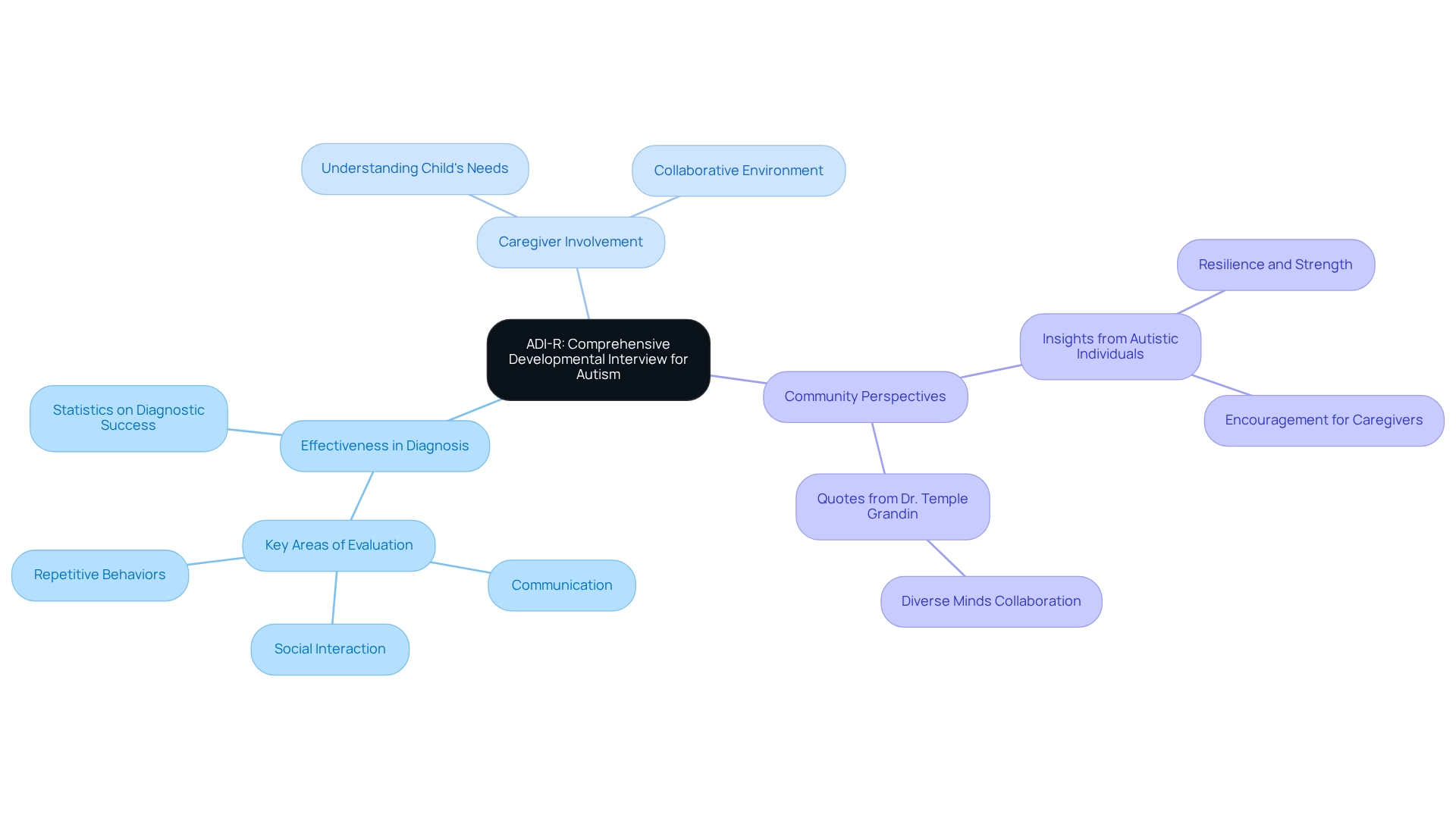
SCQ: Parent-Report Tool for Autism Risk Assessment
The Social Communication Questionnaire (SCQ) is a concise, 40-item parent-report screening tool designed with care to assess communication abilities and social functioning in children. This essential tool helps identify youngsters who may be at risk for spectrum disorders, making it a valuable resource for parents considering an autism test for children, offering them peace of mind. Its quick administration makes it an ideal choice for initial screenings in various environments, including pediatric offices and educational settings.
Recent studies indicate that the SCQ effectively identifies the risk of developmental disorders, with pediatricians recognizing its value in early detection efforts. By focusing on communication skills, the SCQ provides a nuanced understanding of a child's social interactions, which is crucial in the evaluation process. As our understanding of developmental conditions continues to grow, the SCQ is increasingly utilized in educational institutions and pediatric settings, underscoring its importance in fostering timely interventions and support for children and their families, particularly when considering the autism test for children. This information can alleviate some concerns parents may have. Furthermore, Health Secretary Robert F. Kennedy Jr. has announced plans for a 'massive testing and research effort' to identify the causes of developmental disorders, highlighting the importance of tools like the SCQ in these initiatives.
Current usage rates of the SCQ in pediatric environments reflect its growing acceptance and significance in early detection initiatives. This not only emphasizes the SCQ's essential role in risk evaluation but also encourages parents to seek out resources that can support their children's development. If you have experiences or thoughts on this topic, we invite you to share them in the comments or through our newsletters. Together, we can foster a community of understanding and support.
CARS: Behavioral Rating Scale for Autism Severity
The Childhood Autism Rating Scale (CARS) serves as a vital tool for clinicians conducting an autism test for children, designed to identify those with developmental disorders and evaluate the severity of their symptoms. With 15 carefully crafted items, CARS assesses key behaviors associated with these disorders, such as social interaction and communication skills. This structured approach not only aids in recognizing developmental disorders but also plays a crucial role in determining the level of support each child requires, highlighting the significance of the autism test for children, especially since developmental disorders now affect approximately 3% of children.
The importance of instruments like CARS in early detection and planning for necessary support cannot be overstated. Clinicians are increasingly relying on CARS to evaluate severity, highlighting its effectiveness in tailoring strategies to meet individual needs. For instance, a touching case study showcases the Fairy Trail, a community initiative inspired by a mother’s journey with her son’s autism. This project employed CARS to identify specific strategies that fostered community understanding and acceptance, illustrating the real-world application of CARS, while experts emphasize the reliability of CARS, with many clinicians advocating for its use in autism test for children and support planning.
As Alexander Tin, a digital reporter for CBS News, notes, understanding the statistics surrounding autism can significantly enhance awareness and promote early intervention. As our understanding of autism deepens, CARS continues to be a cornerstone in the assessment landscape, ensuring that children receive the tailored support they need to thrive. We encourage parents and caregivers to explore resources available through CARS to better navigate their journey.
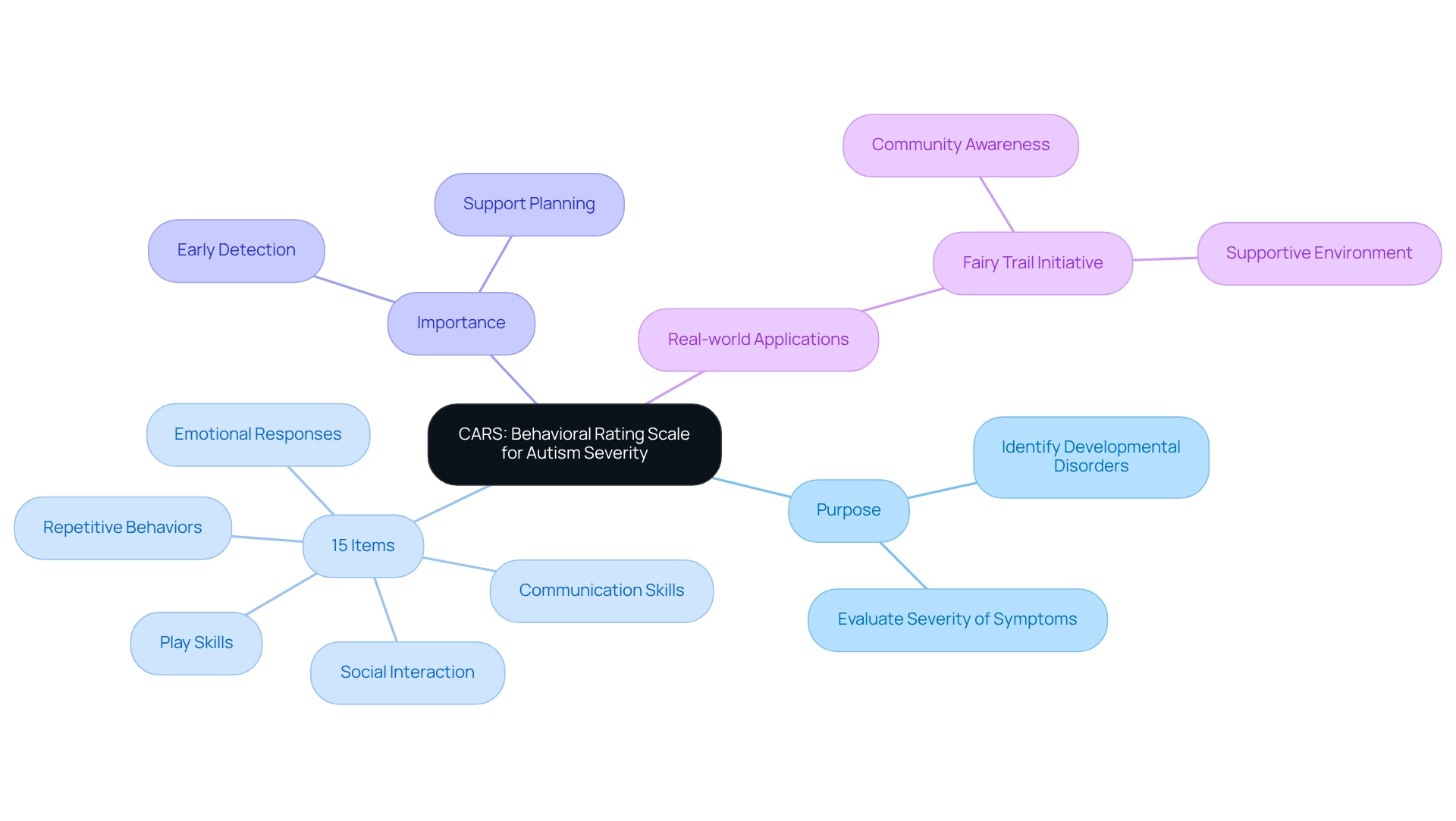
GARS: Identification Tool for Autism in Children and Adolescents
The Gilliam Autism Rating Scale (GARS) serves as a vital tool for identifying autism spectrum disorder in individuals aged 3 to 22 years. This comprehensive evaluation scale includes various items that assess behaviors commonly associated with the condition, allowing clinicians to effectively gauge symptom severity. Recent studies highlight the importance of reliable diagnostic tools like GARS in clinical settings, reinforcing their role in shaping personalized education plans and support services.
As we look ahead to 2025, ongoing research continues to explore the effectiveness of GARS in educational environments. This investigation occurs within a broader context that emphasizes the need for further exploration into diverse therapies for developmental conditions, including those that are less common. Findings reveal no significant correlation between the age or gender of the diagnosis and the version of the scale utilized, showcasing the tool's versatility across different populations. Educational professionals have noted that GARS not only aids in identifying developmental disorders but also enhances the development of tailored interventions that address specific behavioral challenges. This aligns with the critical demand for dependable diagnostic instruments in clinical settings.
Case studies, such as those conducted under the ethical guidelines of the Bahoz center's Ethics Committee, underscore the importance of informed consent and ethical considerations when working with at-risk groups, including children with developmental disabilities. These studies illustrate GARS's effectiveness in real-world applications, highlighting its role in nurturing supportive educational frameworks. Additionally, insights from professionals suggest that Cognitive Behavioral Therapy may be beneficial in addressing anxiety and some core symptoms of the condition, broadening the perspective on treatment options alongside GARS, while educators increasingly recognize the autism test for children as a trustworthy resource for identifying autism in children and adolescents. By evaluating autism-related behaviors, GARS empowers educators to implement strategies that foster positive outcomes for students, ultimately enriching their educational experiences and enhancing their social skills development.
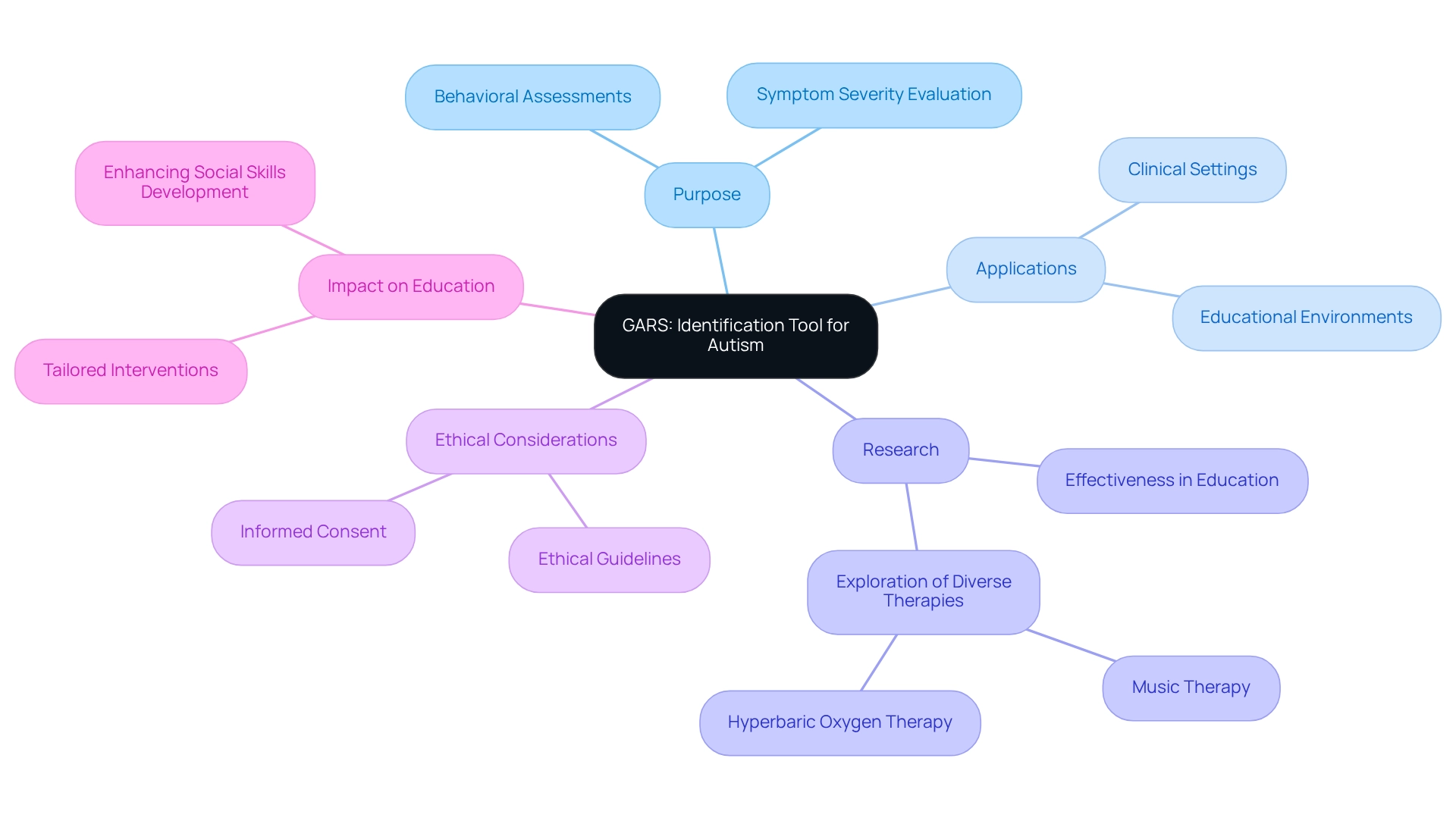
ASRS: Comprehensive Behavior Assessment for Autism
The Autism Spectrum Rating Scales (ASRS) serve as a vital tool for conducting an autism test for children to understand the symptoms and behaviors linked to autism spectrum disorders. By gathering insights from parents, teachers, and clinicians, this multi-informant measure provides a comprehensive view of a child's behavior in different settings. As more parents and educators turn to the ASRS, its effectiveness in identifying specific areas of need becomes increasingly evident.
Experts highlight that the ASRS not only helps identify behavioral challenges but also plays a crucial role in developing targeted intervention strategies. Recent research underscores the incremental validity of ASRS data, showcasing its ability to predict academic competence based on feedback from peers and teachers. These social skills are essential indicators of academic success.
It's important to note that the effectiveness of multi-informant assessments can vary depending on the mental health concerns being evaluated, which emphasizes the need for context when interpreting ASRS results. Case analyses reveal how ASRS has been effectively utilized in multi-informant evaluations, showcasing real-life examples where thorough assessments have led to improved outcomes for youth.
The meticulous search methodology used in these studies resulted in a wealth of articles, ultimately identifying key studies that met the review's inclusion criteria. By leveraging the ASRS, professionals can deepen their understanding of behaviors associated with autism spectrum disorders, using the autism test for children to create more tailored strategies that cater to each child's unique needs. As Robert F. Kennedy Jr. wisely noted, the ASRS is instrumental in guiding interventions, reaffirming its significance in the field. If you’re a parent or educator seeking to better support a child with autism, consider exploring the ASRS further to enhance your approach and understanding.
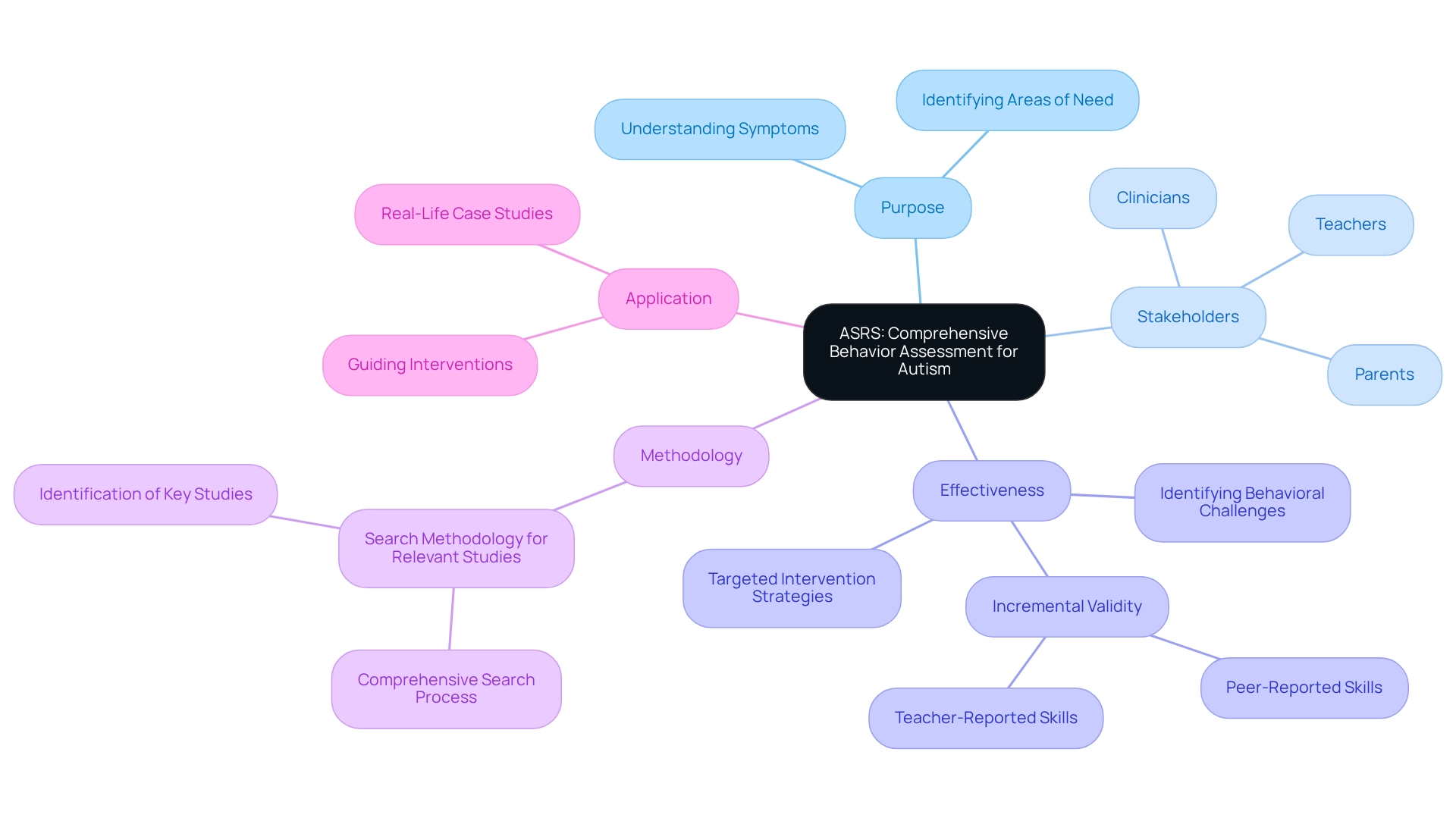
Vineland Scales: Assessing Adaptive Behavior in Autism
The Vineland Adaptive Behavior Scales (VABS) are essential for evaluating adaptive behavior in individuals during an autism test for children. These standardized evaluations focus on crucial skill areas, including communication, daily living, and socialization, providing a comprehensive view of an individual’s functional abilities. By pinpointing specific strengths and weaknesses in adaptive functioning, the VABS play a critical role in crafting effective treatment plans and support services tailored to each individual’s unique needs.
Recent research highlights the effectiveness of the VABS in assessing adaptive behavior, with studies suggesting that these scales can significantly influence support strategies. For example, the Vineland-3 offers optional assessments like the Motor Skills and Maladaptive Behavior Index, which enhance the evaluation process. Clinicians stress the importance of the autism test for children, specifically the VABS, in treatment planning, noting that these assessments not only guide interventions but also track progress over time, ensuring that strategies align with the child’s evolving needs. As Marcus Fuller noted, "These results confirm PMAI can be effective when instructing academic skills to students with ASD; however, further research is required to gain a clearer understanding of who benefits most and under what circumstances PMAI is most effective."
In practical settings, the VABS has been utilized in various case analyses, showcasing its effectiveness in real-world scenarios. One significant study explored the impact of video modeling techniques on functional living skills among individuals with developmental disorders, underscoring the potential of adaptive behavior evaluations to enhance educational outcomes. The findings indicate that while video modeling can improve skills, integrating VABS results into treatment plans is vital for maximizing effectiveness. This study suggests that video modeling interventions are moderately effective in enhancing functional living skills for individuals with ASD.
As current trends in supporting individuals with developmental disorders evolve, ongoing research into the applications of the VABS reinforces its importance in promoting independence and improving the quality of life for those affected. The article detailing these findings spans pages 158-169 in volume 57 of the journal, underscoring the relevance of VABS in contemporary practices.
DST: Tool for Identifying Developmental Delays Including Autism
Developmental Screening Tools (DST) are essential in identifying youth at risk for developmental delays, which may necessitate an autism test for children. These tools assess various developmental areas, such as motor skills, language, and social-emotional growth, providing a holistic view of a young person's progress. Early identification through DST is vital, as it enables timely interventions that can significantly improve developmental outcomes.
Many parents express concerns about the care available for individuals with ASD, often feeling it lacks comprehensiveness and coordination. This highlights the urgent need for effective screening methods. When parents take an active role in seeking an autism test for children, they can facilitate earlier detection and support. For instance, case studies reveal that families advocating for their children often achieve better outcomes. One such study illustrated that parents who proactively pursued screenings were able to access early intervention services, which enhanced their child's communication abilities and social interactions.
The American Academy of Pediatrics emphasizes the increasing prevalence of ASD, noting, "The reported prevalence of individuals with ASD has risen over time, and primary care providers are frequently inquired about the reasons for this rise." This statement underscores the significance of using DST for early detection. Pediatricians strongly recommend these tools, as they aid in identifying developmental delays and assist families in navigating the complexities of the autism test for children.
Despite their importance, statistics show that developmental screening tools are underutilized, with many children missing out on timely evaluations. Research indicates that only about 30% of children receive the recommended screenings by age three. However, when DST is effectively applied, it can lead to remarkable progress in early intervention programs, ensuring that young individuals receive the support they need to thrive. Real-life examples, such as a community health initiative that successfully integrated an autism test for children into routine pediatric visits, highlight the positive impact of these tools across various settings, reinforcing the necessity of such tests in promoting better developmental trajectories for children with autism.
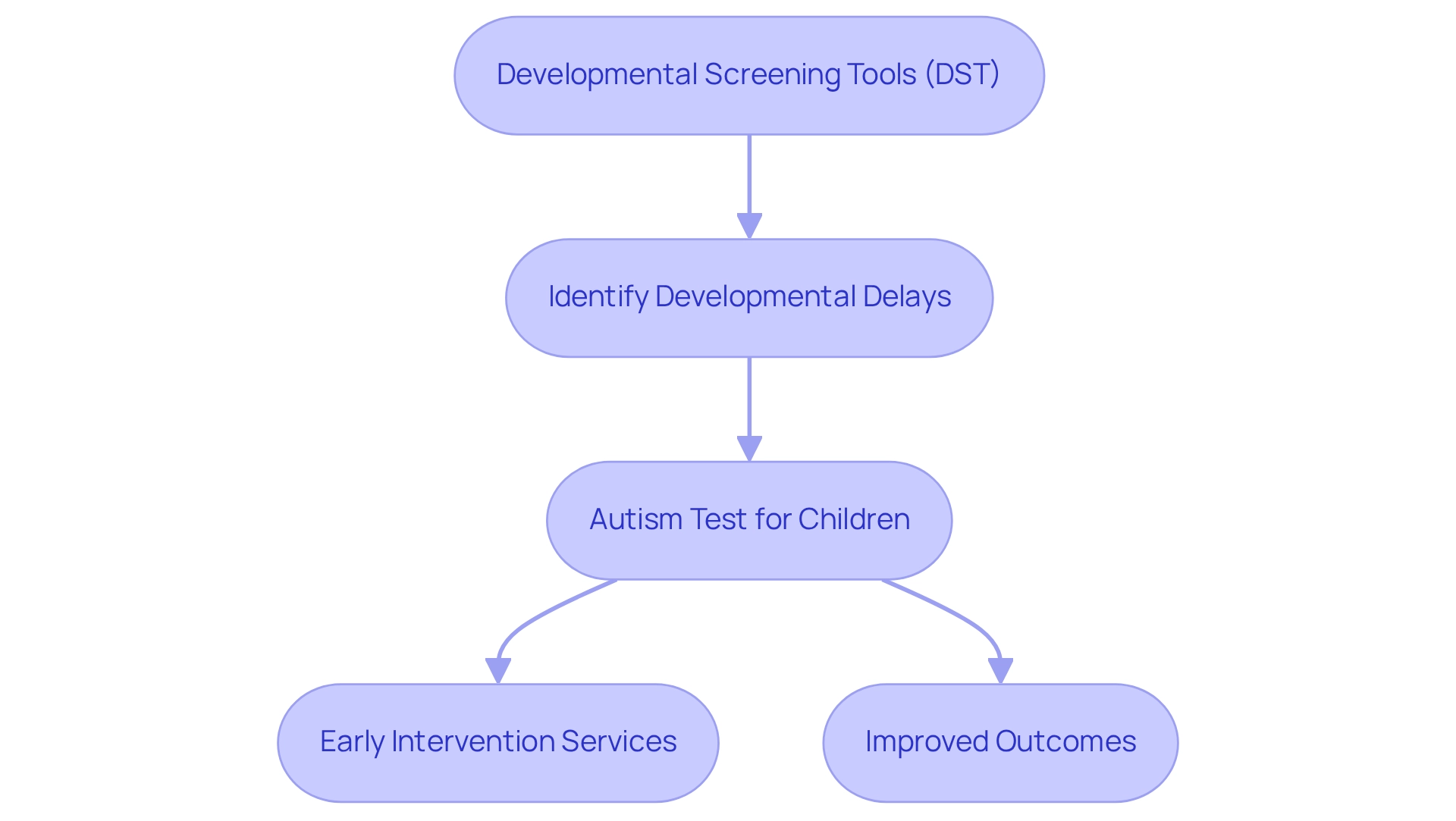
Conclusion
The landscape of autism evaluation offers a wealth of diverse resources and tools that are essential for early detection and intervention. From the Modified Checklist for Autism in Toddlers (M-CHAT-R) to the Autism Diagnostic Observation Schedule (ADOS) and the Autism Spectrum Rating Scales (ASRS), each tool provides unique insights that empower both professionals and parents. These instruments not only streamline the assessment process but also create a collaborative environment that enhances understanding and support for children with autism.
Incorporating these tools into routine practices is crucial for improving outcomes for children diagnosed with autism. The evidence supporting their effectiveness, highlighted by numerous studies and heartfelt parent testimonials, underscores their significance in facilitating timely interventions that can profoundly influence developmental trajectories. Moreover, the community aspect emphasized by organizations like ASD Media illustrates the powerful impact of shared knowledge and support in navigating the complexities of autism evaluation.
Ultimately, the commitment to early detection and comprehensive assessment is vital in ensuring that individuals with autism receive the appropriate interventions they need to flourish. By leveraging these resources, parents and professionals alike can cultivate a nurturing environment that not only addresses the immediate needs of children with autism but also nurtures their potential for a fulfilling life. The collective efforts in this field illuminate a hopeful path forward, paving the way for enhanced understanding, acceptance, and success for individuals on the autism spectrum.
Frequently Asked Questions
What is the mission of ASD Media regarding ABA therapy?
ASD Media is committed to enhancing the application of ABA therapy by providing resources and strategies to address challenges in evaluating individuals with developmental disorders, particularly focusing on autism testing for children.
Why is effective evaluation of developmental disorders important?
With approximately 5.4 million adults on the autism spectrum in the U.S., effective evaluation techniques, such as autism tests for children, are critical for timely intervention and support.
How does ASD Media support parents and professionals in the evaluation process?
ASD Media fosters a supportive community where parents and professionals can share experiences and insights, which leads to better outcomes for children and addresses the mental health needs of parents.
What is the Modified Checklist for Autism in Toddlers, Revised (M-CHAT-R)?
The M-CHAT-R is an autism test designed for children aged 16 to 30 months, consisting of 20 questions that assess behaviors indicative of autism.
How effective is the M-CHAT-R in autism detection?
The M-CHAT-R has proven effective in facilitating timely referrals for further assessment, resulting in a 30% increase in early autism diagnoses according to a 2023 case study.
What are some key features of the M-CHAT-R?
The M-CHAT-R is user-friendly, provides immediate results, and is available in 58 languages and dialects, making it accessible to diverse communities.
What role does the Autism Diagnostic Observation Schedule (ADOS) play in autism assessment?
The ADOS is a semi-structured tool that assesses communication, social skills, and play in individuals suspected of having autism spectrum disorder, and it is crucial for accurate diagnosis.
Why is accurate diagnosis important in the context of autism?
An accurate diagnosis can significantly influence educational outcomes, as statistics indicate that 8% of autistic students in the U.S. do not finish high school, compared to 5% of all students.
What insights does the ADOS provide?
The ADOS yields valuable insights into communication and social interaction, which inform treatment strategies for individuals with autism spectrum disorder.
What should families know about available resources for autism evaluation?
Families should be aware of the various resources, such as the M-CHAT-R and ADOS, which can aid in understanding and supporting their child’s developmental needs.




